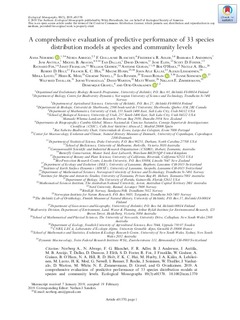| dc.contributor.author | Norberg, Anna | |
| dc.contributor.author | Abrego, Nerea | |
| dc.contributor.author | Blanchet, F. Guillaume | |
| dc.contributor.author | Adler, Frederick R. | |
| dc.contributor.author | Anderson, Barbara J. | |
| dc.contributor.author | Anttila, Jani | |
| dc.contributor.author | Araújo, Miguel B. | |
| dc.contributor.author | Dallas, Tad | |
| dc.contributor.author | Dunson, David | |
| dc.contributor.author | Elith, Jane | |
| dc.contributor.author | Foster, Scott D. | |
| dc.contributor.author | Fox, Richard | |
| dc.contributor.author | Franklin, Janet | |
| dc.contributor.author | Godsoe, William | |
| dc.contributor.author | Guisan, Antoine | |
| dc.contributor.author | OHara, Robert Brian | |
| dc.contributor.author | Hill, Nicole A. | |
| dc.contributor.author | Holt, Robert D. | |
| dc.contributor.author | Hui, Francis K.C. | |
| dc.contributor.author | Husby, Magne | |
| dc.contributor.author | Kålås, John Atle | |
| dc.contributor.author | Lehikoinen, Aleksi | |
| dc.contributor.author | Luoto, Miska | |
| dc.contributor.author | Mod, Heidi K. | |
| dc.contributor.author | Newell, Graeme | |
| dc.contributor.author | Renner, Ian | |
| dc.contributor.author | Roslin, Tomas | |
| dc.contributor.author | Soininen, Janne | |
| dc.contributor.author | Thuiller, Wilfried | |
| dc.contributor.author | Vanhatalo, Jarno | |
| dc.contributor.author | Warton, David | |
| dc.contributor.author | White, Matt | |
| dc.contributor.author | Zimmermann, Niklaus E | |
| dc.contributor.author | Gravel, Dominique | |
| dc.contributor.author | Ovaskainen, Otso | |
| dc.date.accessioned | 2020-01-15T10:28:14Z | |
| dc.date.available | 2020-01-15T10:28:14Z | |
| dc.date.created | 2019-08-13T10:07:49Z | |
| dc.date.issued | 2019 | |
| dc.identifier.citation | Ecological Monographs. 2019, 89:e01370 (3), 1-24. | nb_NO |
| dc.identifier.issn | 0012-9615 | |
| dc.identifier.uri | http://hdl.handle.net/11250/2636382 | |
| dc.description.abstract | A large array of species distribution model (SDM) approaches has been developed for explaining and predicting the occurrences of individual species or species assemblages. Given the wealth of existing models, it is unclear which models perform best for interpolation or extrapolation of existing data sets, particularly when one is concerned with species assemblages. We compared the predictive performance of 33 variants of 15 widely applied and recently emerged SDMs in the context of multispecies data, including both joint SDMs that model multiple species together, and stacked SDMs that model each species individually combining the predictions afterward. We offer a comprehensive evaluation of these SDM approaches by examining their performance in predicting withheld empirical validation data of different sizes representing five different taxonomic groups, and for prediction tasks related to both interpolation and extrapolation. We measure predictive performance by 12 measures of accuracy, discrimination power, calibration, and precision of predictions, for the biological levels of species occurrence, species richness, and community composition. Our results show large variation among the models in their predictive performance, especially for communities comprising many species that are rare. The results do not reveal any major trade‐offs among measures of model performance; the same models performed generally well in terms of accuracy, discrimination, and calibration, and for the biological levels of individual species, species richness, and community composition. In contrast, the models that gave the most precise predictions were not well calibrated, suggesting that poorly performing models can make overconfident predictions. However, none of the models performed well for all prediction tasks. As a general strategy, we therefore propose that researchers fit a small set of models showing complementary performance, and then apply a cross‐validation procedure involving separate data to establish which of these models performs best for the goal of the study. | nb_NO |
| dc.language.iso | eng | nb_NO |
| dc.publisher | Wiley Periodicals, Inc. on behalf of Ecological Society of America | nb_NO |
| dc.rights | Navngivelse 4.0 Internasjonal | * |
| dc.rights.uri | http://creativecommons.org/licenses/by/4.0/deed.no | * |
| dc.title | A comprehensive evaluation of predictive performance of 33 species distribution models at species and community levels | nb_NO |
| dc.type | Journal article | nb_NO |
| dc.type | Peer reviewed | nb_NO |
| dc.description.version | publishedVersion | nb_NO |
| dc.source.pagenumber | 1-24 | nb_NO |
| dc.source.volume | 89:e01370 | nb_NO |
| dc.source.journal | Ecological Monographs | nb_NO |
| dc.source.issue | 3 | nb_NO |
| dc.identifier.doi | 10.1002/ecm.1370 | |
| dc.identifier.cristin | 1715492 | |
| dc.relation.project | Norges forskningsråd: COE GRANT 22325 | nb_NO |
| dc.relation.project | Norges forskningsråd: CoE grant 22325 | nb_NO |
| dc.description.localcode | © 2019 The Authors. Ecological Monographs published by Wiley Periodicals, Inc. on behalf of Ecological Society of America This is an open access article under the terms of the Creative Commons Attribution License, which permits use, distribution and reproduction in any medium, provided the original work is properly cited. | nb_NO |
| cristin.unitcode | 194,66,10,0 | |
| cristin.unitcode | 194,63,15,0 | |
| cristin.unitname | Institutt for biologi | |
| cristin.unitname | Institutt for matematiske fag | |
| cristin.ispublished | true | |
| cristin.fulltext | postprint | |
| cristin.qualitycode | 2 | |

